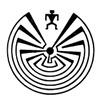Man in the Maze, a recognizable symbol among Native American art, represents challenge and triumph, and is a true symbol of perseverance.
After Se-eh-ha returned to his home in the Greasy Mountains, he decided to build a new home, a dwelling that would be like a labyrinth with winding passages. Its purpose was to bewilder enemies, should they come to destroy him. “I’ll be safe in my lodge in the center of my maze dwelling,” he told himself.
One morning, after he had finished his new home, Se-eh-ha rose very early. The day was calm and bright, but not the heart of Se-eh-ha; it was troubled. He sought to ease his feelings by reminding himself, “Am I not their Creator and Elder Brother?”
He climbed to the top of his new ki (house), shading his eyes from the bright sunlight. AS was his custom, he looked toward the East. He saw a thick cloud of dust appear on the horizon. “Ha! I know the enemy is on his way to destroy me. We’ll see who is more powerful!” Se-eh-ha hurriedly went back to his lodge way down in the heart of the maze.
Before long the warriors arrived shouting their war cry. They found the entrance of the maze wide open. Never had they seen such a strange looking dwelling. It was like the mouth of a big monster, ready to swallow anyone who entered. One by one, the warriors walked in. They quickly walked through the narrow, dark winding halls. Soon, the warriors were groping their way-it was so dark! Some fell, gasping for lack of air. The winding halls were soon cluttered with warriors, stumbling and piling on top of each other.
All the while, Se-eh-ha sat content in his lodge. He knew the army had all perished. Once again, Se-eh-ha was the Conqueror.
It is told by the Old One that Se-eh-ha’s ki (house) is located in the South Mountains near Phoenix, Arizona. In one of the gorges of these mountains, an olla and a grinding stone were found, which the Pimas believe are relics of the past and of the maze dwelling of Se-eh-ha.
Today, the maze pattern is still woven into Pima baskets, and is often featured in Hopi jewelry. It is like the pattern of life-with obstacles to dim the way. But, happy is the man who rises to the top.



